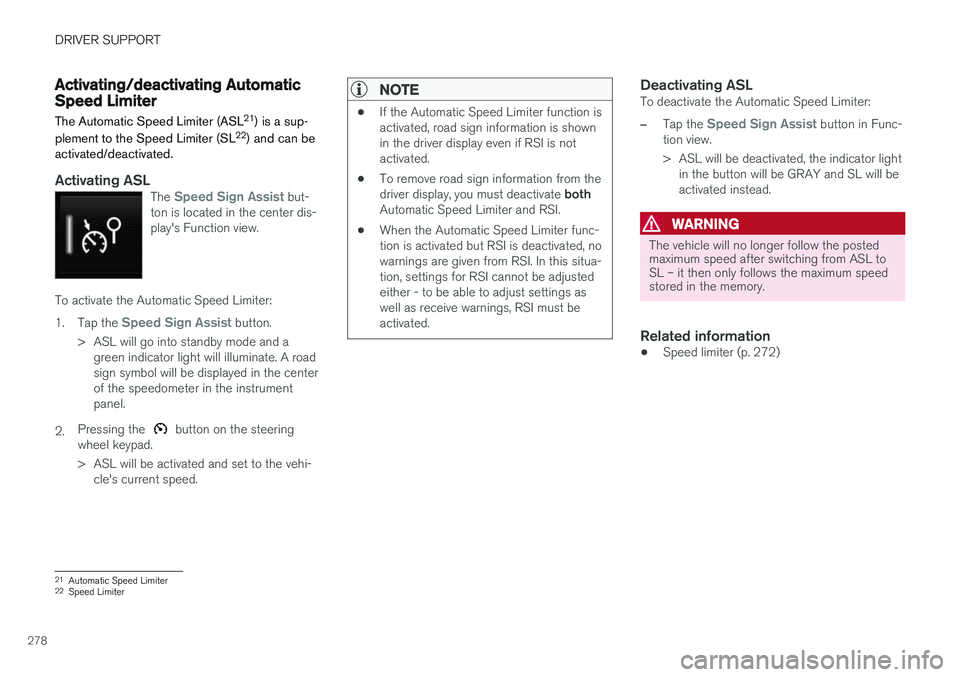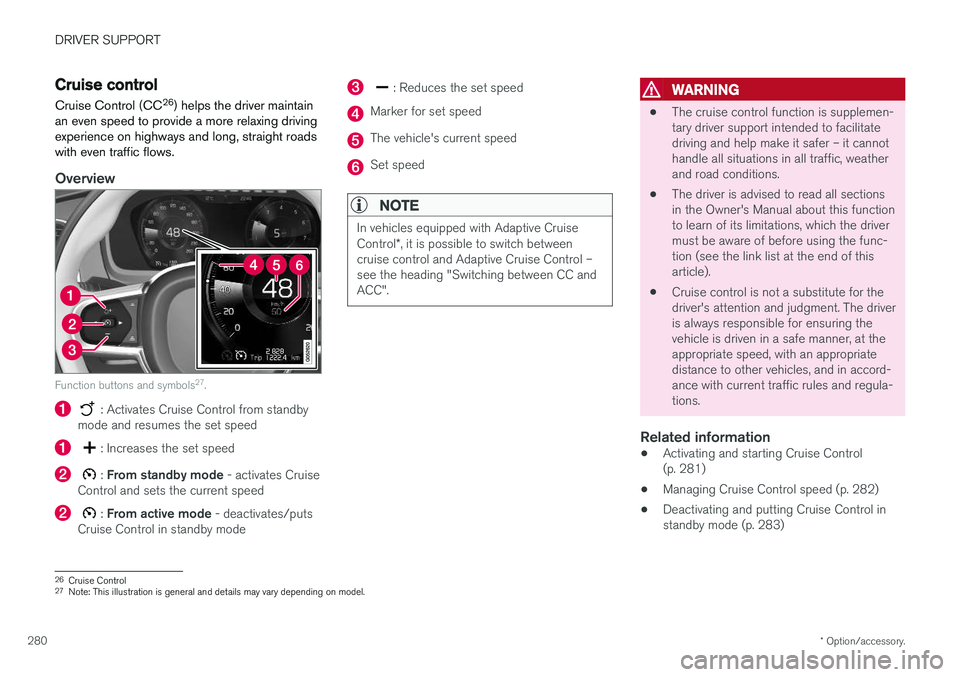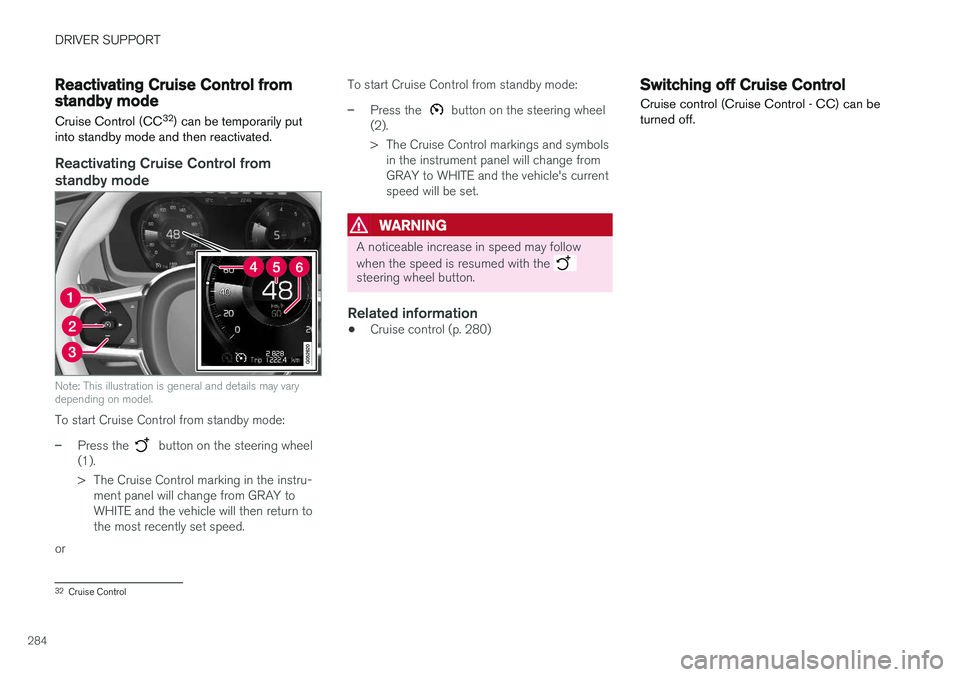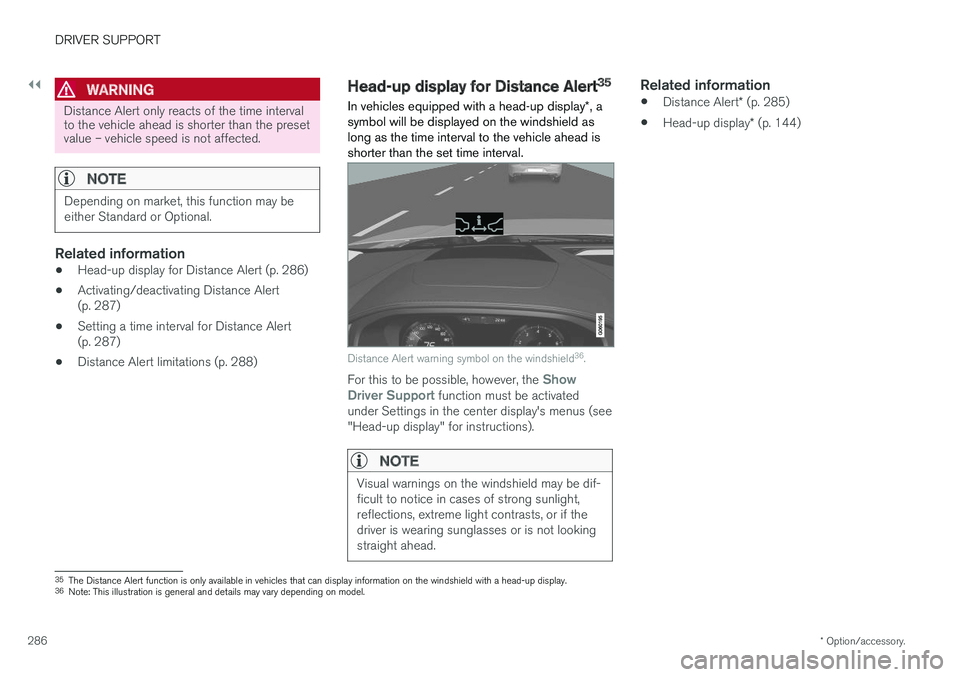2018 VOLVO V90 CROSS COUNTRY warning
[x] Cancel search: warningPage 279 of 662

DRIVER SUPPORT
277
WARNING
•The ASL function is supplementary driver support intended to facilitate driving andhelp make it safer – it cannot handle allsituations in all traffic, weather and roadconditions.
• Even if the driver can clearly see thespeed limit sign, the speed informationfrom the Road Sign Information (RSI)function to ASL may be incorrect. In suchcases, the driver must intervene andaccelerate or brake to an appropriatespeed.
• ASL is not a substitute for the driver'sattention and judgment. The driver isalways responsible for ensuring the vehi-cle is driven in a safe manner, at theappropriate speed, with an appropriatedistance to other vehicles, and in accord-ance with current traffic rules and regula-tions.
• See also the heading "Road Sign Infor-mation limitations".
Is SL or ASL active?The symbols in the instrument panel indicatewhich Speed Limiter function is active:
SymbolSLASL
A✓ ✓
Road sign symbol B
after "70" = ASL is
activated.
✓
A WHITE symbol: The function is active. GRAY symbol: Standby mode.
B See "ASL symbol" below for an explanation of the symbol's dif-ferent colors.
ASL symbol
The road sign symbol (next to the stored speed ("70" here) in the centerof the speedometer) can be displayedin three different colors, which are
explained in the following table:
Road signsymbol's colorExplanation
Greenish-yel- low ASL is active
Gray ASL is in standby mode
Amber/orange ASL is temporarily in standby mode, e.g. because a speed limit sign could notbe read.
Related information
•Speed limiter (p. 272)
Page 280 of 662

DRIVER SUPPORT
278
Activating/deactivating AutomaticSpeed Limiter
The Automatic Speed Limiter (ASL 21
) is a sup-
plement to the Speed Limiter (SL 22
) and can be
activated/deactivated.
Activating ASLThe Speed Sign Assist but-
ton is located in the center dis- play's Function view.
To activate the Automatic Speed Limiter: 1. Tap the
Speed Sign Assist button.
> ASL will go into standby mode and a green indicator light will illuminate. A road sign symbol will be displayed in the centerof the speedometer in the instrumentpanel.
2. Pressing the
button on the steering
wheel keypad.
> ASL will be activated and set to the vehi- cle's current speed.
NOTE
• If the Automatic Speed Limiter function is activated, road sign information is shownin the driver display even if RSI is notactivated.
• To remove road sign information from the driver display, you must deactivate
both
Automatic Speed Limiter and RSI.
• When the Automatic Speed Limiter func- tion is activated but RSI is deactivated, nowarnings are given from RSI. In this situa-tion, settings for RSI cannot be adjustedeither - to be able to adjust settings aswell as receive warnings, RSI must beactivated.
Deactivating ASLTo deactivate the Automatic Speed Limiter:
–Tap the Speed Sign Assist button in Func-
tion view.
> ASL will be deactivated, the indicator light in the button will be GRAY and SL will be activated instead.
WARNING
The vehicle will no longer follow the posted maximum speed after switching from ASL toSL – it then only follows the maximum speedstored in the memory.
Related information
• Speed limiter (p. 272)
21
Automatic Speed Limiter
22 Speed Limiter
Page 282 of 662

DRIVER SUPPORT
* Option/accessory.
280
Cruise control
Cruise Control (CC 26
) helps the driver maintain
an even speed to provide a more relaxing driving experience on highways and long, straight roadswith even traffic flows.
Overview
Function buttons and symbols 27
.
: Activates Cruise Control from standby
mode and resumes the set speed
: Increases the set speed
: From standby mode - activates Cruise
Control and sets the current speed
: From active mode - deactivates/puts
Cruise Control in standby mode
: Reduces the set speed
Marker for set speed
The vehicle's current speed
Set speed
NOTE
In vehicles equipped with Adaptive Cruise Control *, it is possible to switch between
cruise control and Adaptive Cruise Control – see the heading "Switching between CC andACC".
WARNING
• The cruise control function is supplemen- tary driver support intended to facilitatedriving and help make it safer – it cannothandle all situations in all traffic, weatherand road conditions.
• The driver is advised to read all sectionsin the Owner's Manual about this functionto learn of its limitations, which the drivermust be aware of before using the func-tion (see the link list at the end of thisarticle).
• Cruise control is not a substitute for thedriver's attention and judgment. The driveris always responsible for ensuring thevehicle is driven in a safe manner, at theappropriate speed, with an appropriatedistance to other vehicles, and in accord-ance with current traffic rules and regula-tions.
Related information
• Activating and starting Cruise Control(p. 281)
• Managing Cruise Control speed (p. 282)
• Deactivating and putting Cruise Control instandby mode (p. 283)
26
Cruise Control
27 Note: This illustration is general and details may vary depending on model.
Page 286 of 662

DRIVER SUPPORT
284
Reactivating Cruise Control fromstandby modeCruise Control (CC 32
) can be temporarily put
into standby mode and then reactivated.
Reactivating Cruise Control from standby mode
Note: This illustration is general and details may vary depending on model.
To start Cruise Control from standby mode:
–Press the button on the steering wheel
(1).
> The Cruise Control marking in the instru- ment panel will change from GRAY to WHITE and the vehicle will then return tothe most recently set speed.
or To start Cruise Control from standby mode:
–Press the button on the steering wheel
(2).
> The Cruise Control markings and symbols in the instrument panel will change from GRAY to WHITE and the vehicle's currentspeed will be set.
WARNING
A noticeable increase in speed may follow when the speed is resumed with the
steering wheel button.
Related information
• Cruise control (p. 280)
Switching off Cruise Control
Cruise control (Cruise Control - CC) can be turned off.
32 Cruise Control
Page 288 of 662

||
DRIVER SUPPORT
* Option/accessory.
286
WARNING
Distance Alert only reacts of the time interval to the vehicle ahead is shorter than the presetvalue – vehicle speed is not affected.
NOTE
Depending on market, this function may be either Standard or Optional.
Related information
• Head-up display for Distance Alert (p. 286)
• Activating/deactivating Distance Alert (p. 287)
• Setting a time interval for Distance Alert(p. 287)
• Distance Alert limitations (p. 288)
Head-up display for Distance Alert35
In vehicles equipped with a head-up display *, a
symbol will be displayed on the windshield as long as the time interval to the vehicle ahead isshorter than the set time interval.
Distance Alert warning symbol on the windshield 36
.
For this to be possible, however, the Show
Driver Support function must be activated
under Settings in the center display's menus (see "Head-up display" for instructions).
NOTE
Visual warnings on the windshield may be dif- ficult to notice in cases of strong sunlight,reflections, extreme light contrasts, or if thedriver is wearing sunglasses or is not lookingstraight ahead.
Related information
• Distance Alert
* (p. 285)
• Head-up display
* (p. 144)
35
The Distance Alert function is only available in vehicles that can display information on the windshield with a head-up display.
36 Note: This illustration is general and details may vary depending on model.
Page 290 of 662

||
DRIVER SUPPORT
* Option/accessory.
288
NOTE
• The greater the vehicles' speed, the greater the distance between them for aset time interval.
• Only use the time intervals permitted bylocal traffic regulations.
• The set time interval is also used by theAdaptive Cruise Control and Pilot Assistfunctions.
WARNING
•Only use a time interval suitable for the current traffic conditions.
• The driver should be aware that shorttime intervals give them limited time toreact and act to any unforeseen trafficsituation.
Related information
•
Distance Alert
* (p. 285)
Distance Alert limitations39
Distance Alert functionality may be reduced in certain situations.WARNING
• The radar sensor has a limited field of vision. In some situations, it may detect avehicle later than expected or not detectother vehicles at all.
• The radar sensor cannot cover all drivingsituations and traffic, weather and roadconditions.
• The driver is responsible for maintaining asafe distance and speed and must inter-vene if the various driver support systemsdo not maintain a suitable speed or suita-ble distance to the vehicle ahead.
• Maintenance of radar sensor componentsmay only be performed by a trained andqualified Volvo technician.
• Strong sunlight, reflections from the roadsurface, strong lighting contrasts or usingsunglasses may make the warning light inthe windshield difficult to see. Poorweather or winding roads can affect theradar sensor's capacity to detect vehiclesahead.
• A vehicle's size (e.g., a motorcycle) canalso affect the radar sensor's capacity todetect another vehicle. This may result inthe warning light illuminating at a shorter
39
The Distance Alert function is only available in vehicles that can display information on the windshield with a head-up display.
Page 291 of 662

DRIVER SUPPORT
}}
* Option/accessory.289
distance than the one that has been set or not illuminating at all.
• High speeds may also result in the warn-ing light illuminating at a shorter distancethan the one that has been set due tolimitations in the radar sensor's range.
NOTE
The function uses the vehicle's radar unit, which has some general limitations – see thesection "Radar unit limitations".
Related information
•
Distance Alert
* (p. 285)
Adaptive Cruise Control *
Adaptive Cruise Control (ACC 40
) helps the
driver maintain a constant speed with a set time interval to the vehicle ahead.
Adaptive Cruise Control helps provide a more relaxed driving experience on long trips on high-ways or long, straight roads with even trafficflows.
The camera/radar sensor measures the distance to the vehicle ahead 41
.
The driver sets a speed and a time interval to the vehicle ahead. If the camera/radar sensor detects a slower-moving vehicle ahead, your vehicle's speed will be automatically adapted according to the set time interval to that vehicle. When there are no longer slower-moving vehicles ahead, thevehicle will return to the set speed.
WARNING
•
The Adaptive Cruise Control function is supplementary driver support intended tofacilitate driving and help make it safer –it cannot handle all situations in all traffic,weather and road conditions.
• The driver is advised to read all sectionsin the Owner's Manual about this functionto learn of its limitations, which the drivermust be aware of before using the func-tion (see the link list at the end of thisarticle).
• Adaptive Cruise Control is not a substi-tute for the driver's attention and judg-ment. The driver is always responsible forensuring the vehicle is driven in a safemanner, at the appropriate speed, with anappropriate distance to other vehicles,and in accordance with current trafficrules and regulations.
NOTE
Depending on market, this function may be either Standard or Optional.
40
Adaptive Cruise Control
41 Note: This illustration is general and details may vary depending on model.
Page 292 of 662

||
DRIVER SUPPORT
290Adaptive Cruise Control regulates speed by accelerating and braking. It is normal for thebrakes to emit a slight sound when they arebeing used to adjust speed. Adaptive Cruise Control always attempts to regu- late speed smoothly. The driver must apply thebrakes in situations requiring immediate braking.For example, when there are great differences inspeed between vehicles or if the vehicle aheadbrakes suddenly. Due to limitations in the radarsensor, braking may occur unexpectedly or not atall. Adaptive Cruise Control is designed to follow a vehicle ahead in the same lane and maintain atime interval to that vehicle set by the driver. If theradar sensor does not detect a vehicle ahead, itwill instead maintain the speed set by the driver.This will also happen if the speed of the vehicleahead exceeds the set speed for your vehicle.
• Adaptive Cruise Control can follow anothervehicle at speeds from a standstill up to200 km/h (125 mph).
WARNING
• Adaptive Cruise Control is not a collision avoidance system. The driver is alwaysresponsible and must intervene if the sys-tem fails to detect a vehicle ahead.
• Adaptive Cruise Control does not brakefor people or animals and does not brakefor small vehicles, such as bikes andmotorcycles. Similarly, it does not brakefor low trailers, oncoming, slow-moving orstationary vehicles and objects.
• Do not use Adaptive Cruise Control indemanding situations, such as in city traf-fic, at intersections, on slippery surfaces,with a lot of water or slush on the road, inheavy rain/snow, in poor visibility, onwinding roads, or on on/off ramps.
CAUTION
Maintenance of Adaptive Cruise Control com- ponents may only be performed by a work-shop – an authorized Volvo workshop is rec-ommended.
Overview
Controls
Function buttons and symbols 41
.
: Activates Adaptive Cruise Control from
standby mode and resumes the set speed
: Increases the set speed
: From standby mode - activates the
Adaptive Cruise Control and stores the cur- rent speed
: From active mode - deactivates/
switches the Adaptive Cruise Control to standby mode
: Reduces the set speed
Increases the time interval to the vehicle ahead
41 Note: This illustration is general and details may vary depending on model.